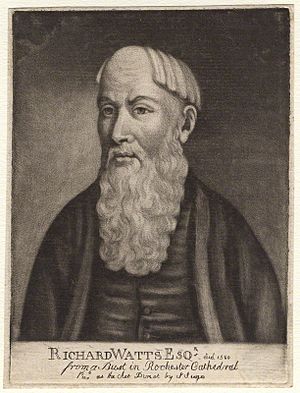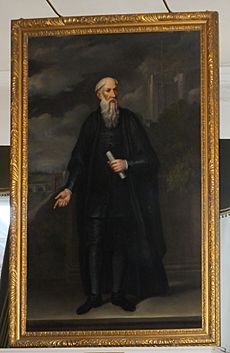Richard Watts facts for kids
Quick facts for kids
Richard Watts
|
|
|---|---|
 |
|
| Born | 1529 |
| Died | 10 September 1579 |
| Resting place | Rochester Cathedral |
| Citizenship | English |
| Occupation | Businessman, MP |
| Years active | 1536–1571 |
| Known for | Philanthropy |
|
Notable work
|
Richard Watts Charity |
| Board member of | Rochester Bridge Trust |
Richard Watts (1529–1579) was a successful businessman and a Member of Parliament (MP) for Rochester in the 1570s. He helped supply food for the English Navy and oversaw the building of Upnor Castle. In 1573, Queen Elizabeth I visited his house. When she said it was satis (Latin for 'enough'), his house became known as Satis House.
Richard Watts was well-known in Rochester for his kindness and generosity. He died on September 10, 1579. In his will, he left money to create the Richard Watts Charity and the Six Poor Travellers House on Rochester High Street. He was buried in Rochester Cathedral, just as he had wished.
Contents
Richard Watts: A Life of Service
Early Life and Business
We don't know the exact date or place Richard Watts was born. It's thought he was born in West Peckham in 1529. Not much is known about his early years. He might have worked for Bishop John Fisher in Rochester. After the Bishop was arrested, Watts returned to Rochester without much money.
By 1550, Richard Watts was a successful merchant. He was paid for supplying food to the army and navy. Around 1552 or 1554, he became the deputy in charge of supplies for the navy. He was given a special coat of arms in 1553.
Royal Appointments and Public Service
In 1559, Richard Watts was again put in charge of navy supplies. Queen Elizabeth I then appointed him to manage the money and building work for Upnor Castle, which started in 1560. He also became the surveyor of weapons in 1562.
In 1560, he also managed the money for the Wardens of Rochester Bridge. In 1563, he was elected as an MP for Rochester. He held this important position until 1571.
His Death and Burial
Richard Watts passed away at home on September 10, 1579. His will described his funeral in detail. He wanted to be buried in Rochester Cathedral, near the steeple and stairs leading to the choir. He asked for a procession from his house to the cathedral, with a priest and the cathedral's "singing children" in their special robes.
After the service, he was buried. He even left money for those who took part, including the people who dug his grave and rang the bells. He was very generous, leaving "One penney in bread and One penny in money" to every "poore Body" who attended his burial. He set aside five pounds for this, expecting about 600 poor mourners.
His grave, with his family's coat of arms, is exactly where he wanted it. In 1730, over 150 years after his death, the city council decided to build a monument to remember him. This memorial, found in the south part of the cathedral, includes a bust of Watts.
Richard Watts' Will and Charity
Instructions for His Legacy
Richard Watts' will spent a lot of time on his funeral plans. The next part of his will left money and income to his wife. It also explained what would happen if she remarried, which she later did. After a few other family gifts, the main part about his charity began.
He wanted the old almshouse (a house for poor people) near the market to be made bigger and better. It would provide a place for travelers who needed a bed for the night. He also wanted raw materials to be given to poor people so they could earn a living.
He asked the Mayor and important citizens of Rochester to "preserve and maintain the stocke" (money and resources). This was so the "yearely gaine" (yearly profits) would help the poor, especially the "poore Travellers". He also made sure his family members would watch over the Mayor. The Archbishop of Canterbury and the Bishop of Rochester would have the final say in any decisions about the charity.
Setting Up the Charity
Watts' will was officially approved on September 25, 1579. However, there were some issues. Some properties he left were jointly owned with his wife, so she became the sole owner. Also, some lands he had given away had returned to their previous owners.
His wife, Marian, did remarry a lawyer named Thomas Pagitt. According to the will, she should have lost the house. But she and her new husband wanted to keep it.
In 1593, an important document called the "Indenture Quadripartite" was created. This agreement involved Marian and Thomas, the Mayor and citizens, the church, and the Rochester Bridge Wardens. Marian was allowed to keep the house. In return, she gave up other claims and returned some money she had received. This long document officially set up the Richard Watts Charity, which still exists today.
Richard Watts Charities Today
The Richard Watts Charity was created from Richard Watts' will in 1579. It aimed to expand and maintain an almshouse in Rochester High Street, now known as the Six Poor Travellers House. The "Indenture Quadripartite" of 1593 formally established how the charity would be run.
Over time, the charity built more almshouses and took in other local charities, like St Catherine's Hospital. As of 2013, Richard Watts Charities provides 66 self-contained homes in Rochester. This includes the almshouses in Maidstone Road, built in 1857.
Changes Over Time
The Charitable Trusts Act of 1853 brought many charities under the supervision of the new Charity Commissioners. Watts' Charity was one of them. A new plan was made for how the charity would operate.
The charity built new almshouses for 20 people in Maidstone Road. They also set aside money to help children pay for apprenticeships after doing well in school. The charity even built the Watts Public Baths, which were used by schools. Many children learned to swim there.
The charity also gave money to St. Bartholomew's Hospital, Rochester to help build a hospital for sick poor people. They continued to support the hospital until 1948, when the National Health Service (NHS) took over.
In 1886, the charity expanded its work again. They offered small weekly payments to people in need and scholarships for students at Sir Joseph Williamson's Mathematical School and Rochester Grammar School for Girls. They also started the Watts Nursing Service.
The Impact of the Welfare State
After World War II, the British Welfare State was created. New laws like the National Insurance Act 1946 and the National Health Service Act 1946 provided universal healthcare and a safety net for people. By 1950, the government was providing many of the services the charity used to offer.
A review in 1954 led to a new plan. The charity still helped travelers in financial need and provided funds for hospitals. Money was also available for apprenticeships, books, and tools. They could also give grants to help people in hardship.
By 1976, the charity had enough money to expand the almshouses. In 1977, several charities, including Richard Watts Charity, combined to form "Richard Watts and the City of Rochester Almshouse Charities."
Watts' Nursing Service
The charity set up a nursing service in 1855 to provide care for new mothers and sick poor people. Care was free. A Head Nurse managed the service and checked on the quality of care.
In the 1930s, the charity hired home-helps to assist new mothers for up to 21 days after birth. They would cook, look after older children, and wash clothes. However, this service became too expensive and stopped after 1938.
The Royal College of Nursing raised concerns in 1941 about the low pay for nurses. Eventually, nurses' salaries were increased. When the National Health Service (NHS) started in 1946, it changed things dramatically. The charity's nursing service became part of the NHS, with the county council funding most of the costs. The charity continued to provide a smaller independent service until 1958, when all patients were transferred to the NHS, and the nursing branch closed.
Watts Public Baths
In 1855, the charity was allowed to build public baths and washhouses. They opened new baths in 1880, offering both private baths and swimming pools. Schools used the swimming pools, and thousands of children learned to swim there.
The baths were never profitable and needed a yearly grant from the charity. In 1935, the baths were given to Rochester Corporation, though the charity continued its annual grant for another 15 years.
Satis House

Queen Elizabeth I stayed with Richard Watts during her royal tour in 1573. When he asked if his house was to her liking, she simply replied 'Satis' (Latin for 'enough'). From then on, the house was known as 'Satis House'.
Archbishop Longley was born in Satis House in 1794.
The house has been rebuilt and is now the main administration building for The King's School, Rochester. A bust of Richard Watts is placed on top of the building. Even though Charles Dickens used the name Satis House in his novel Great Expectations, some parts of the fictional house were actually inspired by nearby Restoration House.
Images for kids
-
As portrayed in Rochester Guildhall.






